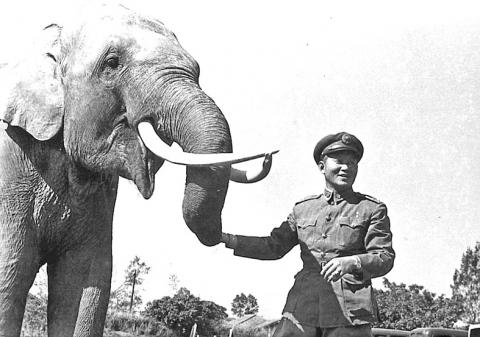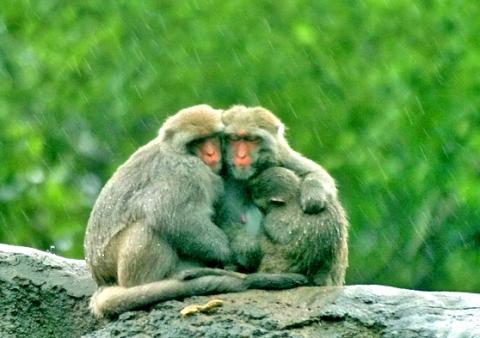Taiwan in Times: Sept. 14 to Sept. 20
It was a memorable morning for many on Sept. 14, 1986 as an estimated 300,000 residents poured into the streets to watch or follow a procession of 65 selected Taipei Zoo animals making their way down the avenues.
After 72 years in Yuanshan (圓山), city officials decided to move the Taipei Zoo to its current location in the Muzha area (木柵) for additional space and better conditions, the new location being 30 times bigger. The former site was also in the flight path of the Songshan Airport (松山機場), which led to noise issues.

Photo: TT
Zoo staff members decided to plan and execute the move on their own, which was risky without an external consultant, but luckily there were no animal fatalities. Many public activities and events were put on for the big move, and Rock Records (滾石唱片) even produced a song Happy Heaven (快樂天堂), sung by all of its artists.
A total of about 1,500 animals were to be transported, but Sept. 14 was the highlight with a big float parade for a selection of popular animals that were shorter than the overpasses and not easily frightened. Twenty painted animal transport cars and other vehicles made the 14.3km journey, stopping at Chiang Kai-shek Memorial Hall and National Taiwan University to massive cheering crowds.
According to the Liberty Daily (自由日報), the animals in the parade consisted of 16 species: tiger, Formosan rock macaque, peacock, lion, leopard, Formosan black bear, raccoon, baboon, jaguar, mountain lion, gorilla, tortoise, orangutan, Angora goat and swan.

Photo: TT
The undisputed biggest star of the zoo, 68-year-old elephant Lin Wang (林旺) wasn’t part of the parade, but his journey a month later also attracted crowds.
ICONIC ELEPHANT
To call Lin Wang’s life extraordinary would be an understatement. Grandpa Lin Wang (林旺爺爺), as he was affectionately called in later life, was originally employed by Japanese troops invading Burma during World War II to transport supplies and artillery. In a battle in 1943, Chinese forces under the command of Sun Li-jen (孫立人) captured Lin Wang and 12 other elephants, eventually taking them back to China after the war ended.

Photo: Wang Min-wei, Taipei Times
Lin Wang spent a year helping build monuments for the fallen and also performing in a circus to raise money for famine relief.
In 1947, Sun was sent to Taiwan, and he brought three elephants, including Lin Wang, with him. By 1951, Lin Wang was the only remaining member of the 13 elephants captured from the Japanese. In 1954, Sun gave him to the Taipei Zoo, where he would eventually become an icon.
Lin Wang was notoriously difficult to move from Yuanshan to Muzha. According to the book, Story of the Zoo (動物園的故事) by former zoo director Chen Bao-chung (陳寶忠), zoo staff had prepared two crates tailored for Lin Wang and his “wife” Ma Lan (瑪蘭). They put the crates in the elephant area two days in advance, and fed them in the crates so the elephants would get used to being in them. Yet, when the day came, Lin Wang bolted out of the crate before staff could close it. Staff continued to entice him with food, but he learned to grab the food with his trunk while using his hind legs to keep the door open. Finally, Lin Wang was “dragged” into the crate by 10 men, but not before breaking two thick ropes.
When the elephant finally arrived at Muzha, he accidentally walked into a ditch after mistaking an elephant-shaped phone booth for Ma Lan. He refused to leave the ditch until Ma Lan emerged from her crate. Lin died in 2003 at the age of 86.
The Taipei Zoo was originally opened by a Japanese national in 1914 as a private zoo, with just 11 animals. The colonial government purchased it in 1915 and officially opened it to the public the next year. The zoo was closed during World War II, and many animals perished. In 1946, less than 200 animals remained.
In 1948, the zoo decided to put on animal performances to entice people to return. The plan worked, and visitors had increased tenfold by 1964. With the admission money, the city could now start purchasing more animals, and by 1971 the zoo was nearing its former glory.
Today, the zoo has nearly 400 species and 3,000 animals.
Taiwan in Time, a column about Taiwan’s history that is published every Sunday, spotlights important or interesting events around the nation that have anniversaries this week.

Following the shock complete failure of all the recall votes against Chinese Nationalist Party (KMT) lawmakers on July 26, pan-blue supporters and the Chinese Communist Party (CCP) were giddy with victory. A notable exception was KMT Chairman Eric Chu (朱立倫), who knew better. At a press conference on July 29, he bowed deeply in gratitude to the voters and said the recalls were “not about which party won or lost, but were a great victory for the Taiwanese voters.” The entire recall process was a disaster for both the KMT and the Democratic Progressive Party (DPP). The only bright spot for

Water management is one of the most powerful forces shaping modern Taiwan’s landscapes and politics. Many of Taiwan’s township and county boundaries are defined by watersheds. The current course of the mighty Jhuoshuei River (濁水溪) was largely established by Japanese embankment building during the 1918-1923 period. Taoyuan is dotted with ponds constructed by settlers from China during the Qing period. Countless local civic actions have been driven by opposition to water projects. Last week something like 2,600mm of rain fell on southern Taiwan in seven days, peaking at over 2,800mm in Duona (多納) in Kaohsiung’s Maolin District (茂林), according to

Aug. 11 to Aug. 17 Those who never heard of architect Hsiu Tse-lan (修澤蘭) must have seen her work — on the reverse of the NT$100 bill is the Yangmingshan Zhongshan Hall (陽明山中山樓). Then-president Chiang Kai-shek (蔣介石) reportedly hand-picked her for the job and gave her just 13 months to complete it in time for the centennial of Republic of China founder Sun Yat-sen’s birth on Nov. 12, 1966. Another landmark project is Garden City (花園新城) in New Taipei City’s Sindian District (新店) — Taiwan’s first mountainside planned community, which Hsiu initiated in 1968. She was involved in every stage, from selecting

As last month dawned, the Democratic Progressive Party (DPP) was in a good position. The recall campaigns had strong momentum, polling showed many Chinese Nationalist Party (KMT) lawmakers at risk of recall and even the KMT was bracing for losing seats while facing a tsunami of voter fraud investigations. Polling pointed to some of the recalls being a lock for victory. Though in most districts the majority was against recalling their lawmaker, among voters “definitely” planning to vote, there were double-digit margins in favor of recall in at least five districts, with three districts near or above 20 percent in